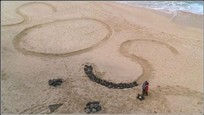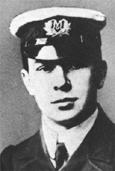S.O.S.
Tato keš je
venována nejznámejšímu nouzovému
signálu, který v roce založení
keše slaví 100 let.
"Vysílejte
SOS!"
Na palube lodi propuká panika poté, co TITANIC
narazil do ledovce.
"Je to nový signál. A tohle je možná
Vaše poslední možnost jej vyslat."
Tato slova údajne pronesl Harold Bride, jeden z
radiooperátoru nejslavnejšího
potopeného parníku sveta, Titanicu, ke svému
kolegovi Jacku Phillipsovi.
|
|
|
Kopie telegrafního
klíce z Titanicu
|
Nový
signál?
Ano, v dobe potopení Titanicu (1912) nebylo
používání signálu SOS,
zvlášte na britských lodích,
príliš zažité.
Signál SOS prvne v rádiovém
vysílání použila nemecká
vláda již roku 1905. Mezinárodne se zacal
signál používat o tri roky pozdeji.
Na mori byl prvne použit lodí Slavonia r. 1909
(všichni cestující byli
zachráneni).
Mnoho operátoru ale ješte, at už z principu nebo
ze setrvacnosti, trvalo na používání
staršího signálu CQD, prípadne
používali signály oba.
Bohužel, signál CQD, který vznikl
sloucením znaku pro všeobecné
volání "CQ" a
písmene "D" jako Distress
(nouze), mohl být snadno zamenen za pouhý
signál CQ, který se používal i pri
banalitách...
Mužeme ríci, že až s potopením
Titanicu, si operátori uvedomili, jak moc je v sázce,
a prakticky ze dne na den prešli na jednotný
signál SOS.
Co oba signály
znamenají?
CQD se nekdy
vykládá jako "Come Quick,
danger!" (Rychle prijedte, nebezpecí) nebo
"Come Quick, Drowning" (Rychle
prijedte, potápíme se) ci dokonce "Come Quick, Dammit!" (Rychle prijedte,
zatracene!). Je to však spíše
mnemotechnická pomucka.
V roce 1904 zavedla Marconiho spolecnost pro své stanice
použití písmen CQD, jako signál v nouzi
(dle obežníku císlo 57 z 1. února 1904
vydaného Marconi Company´s).
Všeobecne byl tento signál vykládán
jako "došlo k nebezpecné situaci", ale dle Marconiho
spolecnosti znamenal CQ – tedy všeobecné
volání, následovaný D –
nebezpecí. Znamenalo by to tedy "Volám všechny stanice – jsem v
nebezpecí".V bezdrátové komunikaci byl
CQD poprvé použit v lednu 1909, když se u
amerického pobreží srazily lode RMS Republic a
SS Florida.
Písmena CQ znejí foneticky velice podobne jako
anglický výraz "seek
you"- hledám te, a dodnes je
používají radioamatéri pri
zahájení relace.
SOS se obvykle
vysvetluje jako "Save Our Ship",
zachrante naši lod, nebo také "Save Our Souls", zachrante/spaste naše
duše. Toto vysvetlení vzniklo –podobne jako u
signálu CQD – až dodatecne.
SOS byl vytvoren z obecného nemeckého
rádiového volání "SOE", kde bylo písmeno E pro
lepší rozpoznatelnost nahrazeno písmenem S
(písmeno E tvorí jen jedna tecka, což je v
horších podmínkách lehce
preslechnutelné).
Navíc se zde nepoužívali mezery
oddelující písmena, takže se
signál snáze vysílal.
| Porovnání SOS |
· · · — — — ·
· · |
ty-ty-ty-tá-tá-tá-ty-ty-ty |
| s CQD |
— · — · / — — ·
— / — · · |
tá-ty-tá-ty tá-tá-ty-tá
tá-ty-ty |
| jasne hovorí pro SOS. |
|
|
 |
Navíc je
skvele citelný
i ve své ne-morseovské podobe,
a tak je možné jeho prostrednictvím
signalizovat volání o pomoc
i bez rádiového spojení.
|
Použití Morseovy abecedy jako prostredku
tísnového volání pro lodi s
výtlakem nad 300 tun bylo oficiálne zrušeno 1.
ledna 1999.
Telegrafický prístroj na palubách techto
plavidel byl nahrazen anténami satelitního a
radiového spojení. Nove používaný
Global Maritime Distress and Safety System - GMDSS
- je ale príliš nákladný, a
menší plavidla si jeho zavedení nemohou
dovolit.
Pobrežní stanice proto dodnes drží dnem i
nocí pohotovost u prijímacu, aby mohly vcas reagovat
na prosbu o pomoc prostrednictvím tradicního
volání SOS.
A tak doufejme,
že signál SOS pomuže zachránit ješte
mnoho životu,
tak jako zachránil život radiotelegrafistovi Haroldu
Bridemu z Titanicu,
ackoliv byl SOS vyslán z Titanicu údajne jen
jednou
(ostatní nouzové volání tvoril sled
signálu CQD).
 |
Harold Bride byl
zachránen lodí Carphatia
a svá zranení prežil.
|
Pro druhého z
radiotelegrafistu,
Jacka Phillipse, bylo bohužel skutecne
vyslání SOS
prvním i posledním pokusem
o použití nového signálu.
Zemrel v záchranném clunu
než dorazila pomoc.
|
 |
Na uvedených souradnicích v Morseove ulici
keš nehledejte, ale mužete si tam od keše
dojít krátkou procházkou pro sladkou
tecku.
Místo uložení keše není
nicím výjimecné, kousek od keše je
pekný výhled na prilehlé vesnice. V
míste se snadno parkuje, keš je takrka drive-in.
Pro nalezeni keše
nemusíte nikde hrabat, nikde šplhat, jen se pozorne
dívat. Keš není navržena pro nocní
odlov, i když ten lze, jen pocítejte se
zhoršenými podmínkami. ŠIŠKY
VÁM NAPOVÍ KUDY Hodne
štestí!
Souradnice
keše.
A= pocet cárek
v krestním jméne sochare a malíre Morsea,
vynálezce abecedy stvorené z tecek a
cárek
B= pocet tecek v
príjmení italského fyzika (1874-1937),
který byl vynálezcem bezdrátové
telegrafie. Jeho objev umožnil, že prenos
telegrafního signálu prestal být
závislý na drátech a stožárech, a
tak se signál uchytil i na lodích.
C = pocet
písmen v príjmení slavného
ceského badatele, který vnukl italskému
fyzikovi myšlenku na telegrafní spojení bez
drátu (Zkuste to bez drátu, milý
.......)
A+B+C=20
N 50°02.(A-1)(C-A)(B-C-1)
E 14°33. (A-4)(B-C)(A+B-5)
EN - This cache is dedicated to the most well known distress
signal, which has its 100th anniversary in the year of the cache
foundation.
On a board a
ship, a panic broke out after the Titanic hit an iceberg. "Send
SOS; it's the new call, and this may be your last chance to send
it."
Allegedly, these words were spoken by Harold Bride, one of the
wireless operators on the famous sinking streamer Titanic, to his
colleague Jack Phillips.
Really, a new signal?
Yes, at the time of the Titanic disaster, the use of the SOS signal
wasn’t so common, especially on British ships. The SOS signal
was first proposed at the International Conference on Wireless
Communication at Sea in Berlin in 1906. It was ratified by the
international community in 1908 and had been in widespread use
since then.
On the sea it was first used by a ship named the Slavonia in 1909
(all passengers survived).
A lot of wireless operators still, by principle or out of habit,
were using the old CQD signal, or both signals.
Unfortunately, the signal CQD, which was made from a combination of
the sign "CQ" for common calls and letter "D" like distress, could
be changed or mistaken for a "CQ" call, which was used
routinely.
We could say that only after the Titanic disaster did the wireless
operators recognize how much was at stake and suddenly began the
regular use of the SOS signal.
What do both signals mean?
CQD -
Contrary to popular belief, CQD does not stand for "Come Quick,
Danger", "Come Quick - Drowning!" or "Come Quick, Dammit!"; these
are ‘backronyms’.
Land telegraphs had traditionally used "CQ" to identify messages of
interest to all stations along a telegraph line, and had also been
adopted as a "general call" for maritime radio use. However, in
landline usage there was no general emergency signal, so the
Marconi company added a "D" to CQ in order to create its distress
call.
In the early morning of January 23, 1909, whilst sailing to New
York from Liverpool, the RMS Republic collided with the Italian
liner SS Florida in a fog off the island of Nantucket,
Massachusetts in the United States. This was the first occasion on
which the CQD distress call had been sent by wireless
transmission.
SOS -
In popular usage, SOS became associated with phrases such as "Save
Our Ship" and "Save Our Souls". These were a later development,
most likely used to help remember the correct letters (something
known as a ‘backronym’).
SOS was developed from the general German radio call "SOE", with
the 3 dits of a "S" easier to hear under noisy conditions than the
single dit of an "E" (which is in Morse code is only one dot) Also,
the otherwise meaningless string of letters was selected because it
is easily recognizable and can be sent rapidly. The SOS distress
call has always been transmitted as a continuous sequence of
dits-and-dahs, and not as individual letters
Comparing SOS (di-di-di-dah-dah-dah-di-di-dit) ( ·
· · — —— · ·
·)
with the older CQD (dah-di-dah-dit dah-dah-di-dah dah-di-dit)(
— ·— · / — — · —
/ — · ·)
it is obvious how much simpler the new code was.
SOS has also been used as a visual distress signal, consisting of
three-short/three-long/three-short light flashes, or with "SOS"
spelled out in individual letters, for example, stamped in a snow
bank or formed out of logs on a beach. The fact that SOS can be
read right side up as well as upside down became important for
visual recognition if viewed from above.
The use of Morse code for ships with draft above 300t was abolished
on 1.1.1999 and they have to use The Global Maritime Distress
Safety System (GMDSS). But, as this is too expensive for many
smaller ships to afford, unto this day, maritime stations keep
emergency watch day and night, ready to help anyone who might send
an SOS.
Let’s hope that the SOS signal will save a lot of
lives like it saved the life of Titanic’s wireless operator
Harold Bride, despite the fact that an SOS was allegedly sent from
Titanic only once (the rest were CQD signals).
For the other wireless operator, Jack Phillips, this SOS signal
transmission was regrettably his first and the last chance to send
it. He died on a rescue boat before help was able to come.
Harold Bride was rescued by the Carphatia and he survived his
injuries.
Cache is not exactly at the coordinates above. They send you to
Morse Street which is just a short walk from the cache and you can
have e a sweet dot/stop(?) there :-)
The area surrounding the hiding place is not especially
extraordinary .
A few meters from the cache there is a nice view of nearby
villages. You can park near the cache easily- it is nearly drive
in.
It is not necessary to dig, or hike;
you only have to look carefully. It is not recommended at night,
but it is possible. IN ANY CASE CONES WILL HELP YOU FIND THE
CACHE.
Good luck! AWCA team
A=how many dashes is in the first name of sculptor
and painter Morse who invented Morse code-the alphabet made from
dots and dashes
B=How many dots is in the surname of the Italian
physicist (1874-1937) who was the inventor of wireless telegraph.
His invention enabled telegraph signals to be sent on the open
sea.
C= how many letters is in the surname of the
famous Czech inventor and deviser, who recommended to the Italian
physicist the idea of a telegraph without wires? He also helped Mr.
Eiffel with his idea of a tower and did a lot of famous and
ingenious things :-)
(SEE http://8.12.42.31/2005/aug/01/world/fg-greatczech1
)
A+B+C=20
N 50°02.(A-1)(C-A)(B-C-1)
E 14°33. (A-4)(B-C)(A+B-5)
http://www.navy-academy.cz/view.php?cisloclanku=2006120001
http://www.ct24.cz/kalendarium/18146-z-more-poprve-zaznel-signal-sos/
http://en.wikipedia.org/wiki/SOS
http://ok1ike.nagano.cz/rs2/clanky/historie/sos_cqd.htm
http://www.telegraph-office.com/tel_off.html
http://www.aktualninet.cz/veda-a-technika-technika-sos-se-ozvalo-uz-z-titanicu-100-let-nouzoveho-volani-fb-5-10-21694.html
http://www.encyclopedia-titanica.org/titanic-biography/john-george-phillips.html
http://www.titanicworld.cz